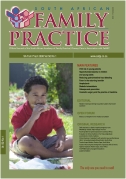Clinical features of Systemic Lupus Erythematosus (SLE) patients attending the SLE outpatient clinic at the Universitas Hospital in Bloemfontein, SA.
Keywords:
Systemic Lupus Erythematosus, profile, clinical features, SLE
Abstract
Background: Systemic lupus erythematosus (SLE) is an autoimmune disease, a type of self-allergy, whereby the patient’s immune system creates antibodies that attack the person’s own body tissues instead of protecting the body from bacteria and viruses. In most cases the cause of SLE is unknown, although it is believed that many factors may be involved, including genetic predisposition and environmental factors such as excessive sun exposure, infections, antibiotics (especially those in the sulpha and penicillin groups), extreme stress, certain drugs, and hormones. Currently, there is no single laboratory test that can determine whether a person has lupus or not. To assist the physician in the diagnosis of lupus, the American College of Rheumatology (ACR) has compiled a list of 11 symptoms or signs of which a person should have four or more to be classified as SLE. The genetic pool and environmental factors differ in different regions. The Free State and Northern Cape are known for a dry and sunny climate, as well as cold winters. The aim of this study was to determine the most common features of patients with systemic lupus erythematosus attending the outpatient clinic at Universitas Hospital in Bloemfontein, South Africa. Methods: For this descriptive study, the study population included all patients attending the SLE clinic at Universitas Hospital diagnosed with SLE according to the ACR classification criteria. Patients were only included if they had at least one follow-up visit. Patients who had discoid lupus were excluded. Data were collected from patient files using a confidential and anonymous data form. Results: Data were obtained from 76 patients: 71 females (94.7%) and five males (5.3%). African patients accounted for 61.3% of the study population, whites for 33.9%, Asians for 1.6% and coloureds for 3.2%. Patients most frequently had immunological (90.8%), mucocutaneous (86.9%), musculoskeletal (85.5%) and cardiovascular problems (77.6%). Conclusion: Most of the findings correlate with similar studies worldwide. However, mucocutaneous manifestations and Raynaud’s phenomenon were more prevalent in our study population. From this it can be deduced that the climate may play an important role. Further research needs to be conducted to investigate this hypothesis.
Published
2008-01-17
Section
Original Research
By submitting manuscripts to SAFP, authors of original articles are assigning copyright to the South African Academy of Family Physicians. Copyright of review articles are assigned to the Publisher, Medpharm Publications (Pty) Ltd, unless otherwise specified. Authors may use their own work after publication without written permission, provided they acknowledge the original source. Individuals and academic institutions may freely copy and distribute articles published in SAFP for educational and research purposes without obtaining permission.

